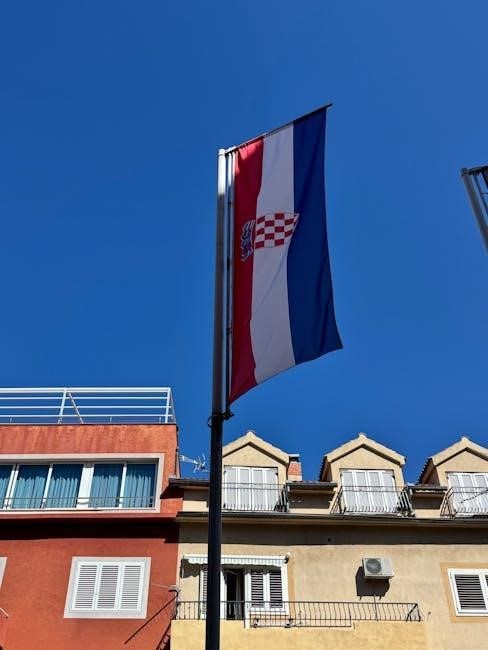Chris Voss‚ a former FBI hostage negotiator‚ shares his expertise in Never Split the Difference‚ offering tactical strategies for negotiation. The book emphasizes understanding human behavior‚ emotional dynamics‚ and psychological principles to achieve optimal outcomes. The Never Split the Difference cheat sheet PDF provides a concise guide to mastering these techniques‚ making it an invaluable resource for anyone seeking to enhance their negotiation skills.
Key Concepts and Techniques
Never Split the Difference outlines strategies like tactical empathy‚ mirroring‚ labeling‚ and calibrated questions. The Ackerman Model and the “Late-Night FM DJ Voice” are also highlighted as powerful negotiation tools.
Tactical Empathy
Tactical empathy‚ a core concept in Never Split the Difference‚ involves understanding and acknowledging the emotions and needs of the other party. It’s not about agreeing but about making the counterpart feel heard and validated. This technique‚ derived from Chris Voss’s FBI negotiation experience‚ helps build trust and de-escalate tensions. By actively listening and showing genuine interest‚ negotiators can uncover hidden fears and desires‚ gaining a strategic advantage. Tactical empathy is particularly effective in high-stakes situations‚ where emotions run high. The Never Split the Difference cheat sheet PDF emphasizes its importance‚ providing practical tips on how to implement this strategy effectively. Mastering tactical empathy allows negotiators to connect deeply with others‚ fostering collaboration and driving successful outcomes.
Mirroring and Labeling
Mirroring and labeling are powerful techniques in Never Split the Difference that foster rapport and control in negotiations. Mirroring involves repeating key phrases spoken by the counterpart to show understanding and build trust. This subtle tactic encourages them to elaborate‚ revealing valuable insights. Labeling takes it further by acknowledging their emotions or concerns‚ such as “It seems like you’re feeling frustrated.” Both strategies‚ rooted in psychological principles‚ help negotiators align with the other party’s perspective‚ reducing resistance. The Never Split the Difference cheat sheet PDF highlights these methods as essential tools for managing high-stakes conversations. By mastering mirroring and labeling‚ negotiators can steer discussions toward mutually beneficial outcomes‚ ensuring clarity and cooperation. These techniques emphasize the importance of emotional intelligence in achieving successful negotiations.
Calibrated Questions
Calibrated questions are a cornerstone of Chris Voss’s negotiation strategies in Never Split the Difference. These are carefully crafted open-ended questions that guide the conversation without forcing a specific response. They often begin with “how” or “what‚” encouraging the counterpart to think deeply and reveal their true needs‚ fears‚ and motivations. Unlike direct questions‚ calibrated questions create a collaborative environment‚ making the other party feel heard and understood. This technique reduces tension and fosters trust‚ allowing negotiators to uncover hidden information. The Never Split the Difference cheat sheet PDF emphasizes the importance of calibrated questions in high-stakes negotiations‚ providing practical examples to help users master this approach. By using these questions‚ negotiators can gain control while maintaining a respectful and constructive dialogue‚ ultimately driving the conversation toward a favorable outcome.
The Ackerman Model
The Ackerman Model‚ introduced by Chris Voss in Never Split the Difference‚ is a systematic negotiation tactic designed to create a psychological anchor that nudges the counterpart toward your desired outcome. This model involves making a series of calibrated offers‚ each slightly less favorable than the previous one‚ to push the other party toward a compromise. The strategy relies on the psychological principle that people prefer incremental concessions over abrupt changes. The Never Split the Difference cheat sheet PDF highlights the effectiveness of this approach in high-stakes negotiations‚ offering a step-by-step guide to implementing it. By using the Ackerman Model‚ negotiators can create a framework that encourages the counterpart to accept a deal that aligns with their interests while maintaining a sense of control and fairness.
The Late-Night FM DJ Voice
The Late-Night FM DJ Voice‚ a concept popularized by Chris Voss in Never Split the Difference‚ refers to the use of a calm‚ steady‚ and soothing tone during negotiations. This voice is designed to reduce tension and build trust‚ creating an environment where the other party feels safe to open up. The technique involves speaking in a low‚ controlled pitch‚ avoiding any signs of aggression or urgency. Voss emphasizes that this voice should be used consistently‚ even when the conversation becomes heated. The Never Split the Difference cheat sheet PDF outlines how this approach can help negotiators maintain composure and strategically guide the conversation. By adopting this tone‚ negotiators can establish rapport‚ diffuse emotional conflicts‚ and create a platform for constructive dialogue. This subtle yet powerful tool is a cornerstone of Voss’s negotiation strategies.
The Mirror Process
The Mirror Process‚ as outlined in Chris Voss’s Never Split the Difference‚ is a powerful negotiation technique that involves mirroring the words and emotions of the other party. This process creates a psychological loop‚ making the speaker feel heard and validated. By repeating key phrases or sentences‚ negotiators build rapport and encourage the other side to elaborate. The Never Split the Difference cheat sheet PDF highlights how this tactic fosters trust and deepens understanding. Mirroring should be subtle‚ focusing on meaningful words rather than entire sentences. It also helps to identify underlying concerns and gain control of the conversation. When done correctly‚ the Mirror Process shifts the dynamics‚ making the other party more open to collaboration. This technique is a cornerstone of tactical empathy‚ enabling negotiators to navigate high-stakes situations effectively.

Tactical Silence
Tactical Silence is a negotiation strategy emphasized in Chris Voss’s Never Split the Difference. It involves using silence as a tool to create discomfort in the other party‚ encouraging them to reveal more information or concede. Silence‚ when deployed strategically‚ can shift the balance of power in negotiations. According to the Never Split the Difference cheat sheet PDF‚ Tactical Silence works by letting the other side fill awkward silences‚ often leading them to disclose critical details or agree to terms. This technique is particularly effective after a calibrated question‚ as it compels the opponent to respond. By remaining silent‚ negotiators can avoid making unnecessary concessions and instead force the other party to make the first move. Tactical Silence is a subtle yet powerful method to gain leverage in high-stakes conversations.
Strategic Use of “No”
The Strategic Use of “No” is a cornerstone concept in Chris Voss’s Never Split the Difference. According to the Never Split the Difference cheat sheet PDF‚ saying “No” is not about closing doors but creating opportunities. Voss explains that “No” is a powerful tool that sets boundaries‚ clarifies expectations‚ and forces the other party to rethink their position. By saying “No‚” negotiators can regain control of the conversation‚ create psychological distance‚ and encourage the opponent to offer concessions. The technique involves delivering “No” calmly and confidently‚ often early in the negotiation‚ to establish a strong stance. This tactic also prevents overcommitting and ensures that the negotiator’s interests remain protected. When used effectively‚ “No” can shift the dynamic‚ making the other side more willing to compromise. It’s a simple yet potent strategy to achieve better outcomes in high-stakes negotiations.

The Power of “Why?”
In Never Split the Difference‚ Chris Voss highlights the power of asking “Why?” as a negotiation tactic. According to the Never Split the Difference cheat sheet PDF‚ this simple question is a game-changer. By asking “Why?”‚ negotiators can uncover the other party’s underlying motivations‚ needs‚ and fears. This creates a safe space for the opponent to express themselves‚ fostering trust and openness. Voss emphasizes that “Why?” is not confrontational but rather an invitation to share. It allows negotiators to understand the real issues at play‚ which is critical for crafting tailored solutions. Additionally‚ “Why?” helps to diffuse tension and redirects the conversation toward collaboration. When used strategically‚ this question can reveal hidden opportunities‚ making it easier to find mutually beneficial agreements. Mastering “Why?” is essential for anyone aiming to excel in high-stakes negotiations.

Spotting Liars and Deception
In Never Split the Difference‚ Chris Voss provides insights into identifying deception during negotiations‚ as outlined in the Never Split the Difference cheat sheet PDF. He explains that detecting lies is not about accusing but understanding the other party’s behavior. Key indicators include inconsistencies in their story‚ avoidance of direct eye contact‚ and excessive use of words like “honestly” or “truthfully.” Voss also emphasizes the importance of tactical empathy to uncover hidden motives. By actively listening and observing verbal and non-verbal cues‚ negotiators can identify potential deception. Additionally‚ asking calibrated questions forces the opponent to reveal inconsistencies. These techniques help negotiators stay one step ahead‚ ensuring they are not misled. Mastering these strategies is crucial for achieving truthful and transparent negotiations‚ ultimately leading to more favorable outcomes. Recognizing deception is a vital skill in high-stakes situations‚ and Voss’s methods provide a clear path to doing so effectively.
The Importance of “That’s Right”
In Never Split the Difference‚ Chris Voss highlights the power of the phrase “That’s Right” as a negotiation tool‚ as detailed in the Never Split the Difference cheat sheet PDF. This phrase serves as a psychological trigger‚ helping to build rapport and trust. By acknowledging the other party’s perspective‚ you create a sense of validation‚ which encourages honesty and openness. Voss explains that “That’s Right” is not about agreement but about understanding. It signals that you comprehend their viewpoint‚ making them more likely to collaborate. This technique also helps to de-escalate tension and fosters a collaborative environment. When used correctly‚ it becomes a powerful way to guide the conversation toward a mutually beneficial outcome. Incorporating “That’s Right” into your negotiations can significantly enhance your ability to influence and persuade‚ making it a cornerstone of effective communication strategies.
In Never Split the Difference‚ Chris Voss outlines a range of negotiation strategies that can be applied in high-stakes situations. These strategies are designed to help negotiators gain control‚ build rapport‚ and achieve optimal outcomes. Key techniques include tactical empathy‚ mirroring‚ and calibrated questions‚ all of which focus on understanding the counterpart’s perspective. The Ackerman Model provides a framework for making strategic concessions‚ while the late-night FM DJ voice helps establish a calm and authoritative tone. Additionally‚ the book emphasizes the importance of tactical silence‚ the power of “no‚” and the use of “that’s right” to validate the other party’s feelings. By combining these strategies‚ negotiators can create a psychological advantage‚ leading to more successful and efficient negotiations. The Never Split the Difference cheat sheet PDF distills these concepts into actionable steps for real-world application.

Psychological Principles in Negotiation
Chris Voss highlights psychological principles like understanding human behavior‚ primal urges‚ and cognitive biases to influence negotiations effectively‚ ensuring strategies align with natural decision-making processes.
Understanding Human Behavior
Understanding human behavior is a cornerstone of effective negotiation‚ as it allows negotiators to anticipate and influence the other party’s actions. Chris Voss emphasizes the importance of recognizing that people are driven by emotions‚ needs‚ and subconscious influences. By understanding these factors‚ negotiators can tailor their approach to align with the counterpart’s psychological makeup. Trust and rapport are critical‚ as they create a foundation for open communication. Voss highlights that people are more likely to collaborate when they feel heard and understood. This understanding also enables negotiators to identify underlying motivations‚ such as the need for control or fear of loss‚ and address them strategically. By leveraging these insights‚ negotiators can guide the conversation toward mutually beneficial outcomes‚ ensuring both parties feel valued and heard.
The Two Primal Urges
Chris Voss identifies two primal human urges that drive behavior in negotiations: the need to be understood and the need to feel safe. These instincts are deeply rooted in human psychology and influence how people react in high-stakes situations. The first urge‚ the need to be understood‚ compels individuals to express themselves and have their perspectives acknowledged. The second urge‚ the need to feel safe‚ manifests as a desire to avoid loss or harm. By addressing these primal drives‚ negotiators can create an environment where the counterpart feels secure and valued. Voss emphasizes that understanding these urges allows negotiators to tailor their approach‚ build trust‚ and guide the conversation toward a resolution that satisfies both parties. This insight is crucial for mastering the art of negotiation and achieving successful outcomes.
Cognitive Biases
Cognitive biases are systematic patterns of deviation from normative judgment‚ often influencing decision-making in negotiations. Chris Voss highlights several key biases that negotiators must understand and leverage. The loss aversion bias‚ where people fear losses more than they value gains‚ can be used to frame offers carefully. The anchoring bias demonstrates how initial numbers or ideas heavily influence final decisions‚ making it crucial to set the first offer strategically. Additionally‚ the confirmation bias‚ where individuals favor information that confirms their preexisting beliefs‚ can be countered by acknowledging their perspective. Lastly‚ the sunk cost fallacy leads people to continue investing in a losing situation due to past commitments. By recognizing these biases‚ negotiators can avoid falling into traps and instead guide the conversation to achieve better outcomes. Understanding cognitive biases is a cornerstone of Voss’s negotiation strategy‚ enabling negotiators to make informed‚ strategic decisions.
The Role of Emotions in Negotiation
Emotions play a pivotal role in negotiation‚ often driving decisions more than logic. Chris Voss emphasizes the importance of understanding and managing emotions to achieve successful outcomes. Tactical empathy‚ a core concept‚ involves acknowledging and mirroring the other party’s feelings to build trust and rapport. By labeling emotions‚ negotiators can diffuse tension and create a safe environment for open dialogue. Voss also highlights the need to remain calm and composed‚ as emotional control is key to making strategic decisions. Additionally‚ he stresses the importance of understanding the emotional drivers of the opposing party‚ such as fear‚ greed‚ or pride‚ to tailor your approach effectively. Mastering emotional intelligence allows negotiators to navigate high-stakes conversations with confidence and precision‚ ultimately leading to more favorable results. Recognizing and addressing emotions is not just a tactic—it’s a fundamental aspect of negotiation success.
The Art of Active Listening
Active listening is a cornerstone of effective negotiation‚ as emphasized in Never Split the Difference. It involves fully engaging with the speaker‚ understanding their perspective‚ and demonstrating that you value their words. Chris Voss highlights the importance of maintaining eye contact‚ nodding‚ and using verbal cues like “uh-huh” to show attentiveness. This technique helps build trust and encourages the other party to share more information. By focusing intently on the speaker‚ negotiators can uncover underlying needs‚ desires‚ and concerns that might otherwise go unspoken; Active listening also helps to de-escalate tensions and creates a collaborative environment. Voss stresses that this is not passive hearing but an active process of engagement‚ which can significantly shift the dynamics of a negotiation in your favor. Mastering this skill is essential for achieving mutually beneficial outcomes.
Implementing the “No” Strategy
In Never Split the Difference‚ Chris Voss underscores the strategic importance of the word “No” in negotiations. The “No” strategy is not about refusing or rejecting but about creating psychological safety and control. By inviting the other party to say “No‚” you empower them‚ reducing their defensiveness and fostering collaboration. This approach allows negotiators to set boundaries and clarify expectations without alienating the counterpart. Voss suggests that “No” can be a powerful tool to redirect conversations‚ create pauses‚ and regain the upper hand. It’s essential to deliver “No” calmly and confidently‚ ensuring it’s seen as a natural part of the dialogue. Mastering the “No” strategy enables negotiators to navigate high-stakes situations effectively‚ ultimately leading to more favorable outcomes. This technique is a cornerstone of Voss’s negotiation framework‚ emphasizing clarity and strategic communication.

The “Bend Reality” Framework
The “Bend Reality” framework‚ as outlined in Never Split the Difference‚ is a psychological strategy to influence the perception of reality in negotiations. Chris Voss explains that this framework is not about manipulation but about shaping the other party’s perspective to align with your goals. It involves using techniques like tactical empathy‚ mirroring‚ and calibrated questions to create a mental framework that makes your counterpart more receptive to your position. By subtly guiding their focus and emotions‚ you can make them feel in control while steering the conversation toward a favorable outcome. This approach emphasizes the importance of understanding human psychology and leveraging it ethically to achieve mutually beneficial results. The “Bend Reality” framework is a powerful tool for negotiations‚ enabling you to reshape perceptions and create opportunities for agreement.
The “Accusation Audit”
The “Accusation Audit” is a negotiation technique introduced by Chris Voss in Never Split the Difference. It involves preemptively addressing the worst accusations or objections your counterpart might have against you. By acknowledging these potential criticisms upfront‚ you create a safe environment for the other party to engage openly. This strategy builds trust and demonstrates transparency‚ making the negotiation process smoother. Voss suggests listing all possible negative accusations and addressing them directly‚ even if they haven’t been voiced. This approach allows you to control the narrative and diffuse tension before it escalates. The “Accusation Audit” is a powerful tool for neutralizing opposition and fostering collaboration‚ ensuring that negotiations remain fair and productive. It’s a proactive way to manage conflicts and achieve mutually beneficial outcomes.

The “Black Swan” Concept
The “Black Swan” concept‚ inspired by Nassim Nicholas Taleb‚ refers to rare‚ unpredictable events with significant consequences. In Never Split the Difference‚ Chris Voss adapts this idea to negotiation‚ emphasizing the power of unexpected information or revelations. A “Black Swan” in negotiation is a piece of information that radically changes the dynamics of the conversation‚ often in your favor. Voss suggests that skilled negotiators should actively seek out or create these moments by uncovering hidden truths or leveraging surprising facts. This strategy allows you to gain the upper hand by addressing the other party’s unspoken fears or desires. The “Black Swan” concept underscores the importance of preparation and creativity in high-stakes negotiations‚ enabling you to turn seemingly insurmountable obstacles into opportunities. By mastering this approach‚ you can reshape the narrative and achieve outcomes that might otherwise seem impossible.

Case Studies and Real-World Applications
Chris Voss’s Never Split the Difference is rich with real-world examples that demonstrate the practical application of his negotiation techniques. One notable case study involves a high-stakes kidnapping negotiation‚ where Voss successfully used Tactical Empathy to build rapport with the kidnapper‚ ultimately securing the release of the hostage. Another example highlights how the Late-Night FM DJ Voice and Mirroring strategies were employed to de-escalate a tense standoff with a barricaded suspect. These scenarios illustrate how the techniques outlined in the book can be applied in life-or-death situations‚ as well as in business and personal negotiations. Voss also shares examples of how these strategies have been used by law enforcement‚ CEOs‚ and everyday individuals to achieve favorable outcomes. These case studies underscore the versatility and effectiveness of the methods‚ proving that they work in diverse contexts.

Chapter-by-Chapter Summary
Never Split the Difference is divided into 17 chapters‚ each focusing on distinct negotiation strategies. Chapter 1 introduces Voss’s journey and the concept of Tactical Empathy. Chapters 2-4 delve into advanced tactics like Mirroring and Labeling‚ while Chapter 5 explores the power of calibrated questions. The Ackerman Model for bargaining is detailed in Chapter 6‚ and Chapter 7 emphasizes the importance of the Late-Night FM DJ Voice. Chapters 8-10 discuss the psychology of negotiation‚ including the role of emotions and the “No” strategy. Chapter 11 highlights the “Bend Reality” framework‚ and Chapter 12 covers the “Accusation Audit.” Chapters 13-15 focus on mastering high-stakes conversations and understanding human behavior. The final chapters provide practical advice for implementing these techniques in real-world scenarios. This structure ensures a comprehensive understanding of Voss’s negotiation philosophy.
How to Use the Cheat Sheet Effectively
To maximize the value of the Never Split the Difference cheat sheet‚ start by reviewing it before any negotiation. Focus on the key strategies and techniques‚ such as Tactical Empathy‚ Mirroring‚ and the “No” Strategy. Prioritize the most relevant techniques based on the situation. Practice active listening and use the cheat sheet to refine your approach. Refer to it after negotiations to analyze what worked and what didn’t. Use the cheat sheet as a quick reference guide to ensure you’re applying Voss’s principles consistently. Over time‚ the strategies will become second nature‚ enhancing your negotiation skills significantly. By integrating the cheat sheet into your preparation and review process‚ you’ll master the art of high-stakes communication and achieve better outcomes.

The Science Behind the Techniques
The negotiation strategies in Never Split the Difference are rooted in psychological principles and scientific research. Chris Voss leverages cognitive biases‚ emotional responses‚ and human behavior patterns to create effective techniques. For instance‚ Tactical Empathy aligns with emotional intelligence‚ enabling negotiators to connect deeply with counterparts. Mirroring and Labeling draw from neurolinguistic programming‚ fostering rapport and understanding. The “No” Strategy and Tactical Silence exploit the psychological discomfort of silence‚ giving negotiators an edge. These methods are scientifically validated‚ ensuring their reliability in high-stakes situations. By understanding the brain’s response to stress‚ loss aversion‚ and the need for control‚ Voss’s techniques empower negotiators to influence outcomes predictably. This blend of psychology and practical application makes the book a powerful tool for mastering negotiations.
Mastering High-Stakes Conversations
Mastering high-stakes conversations requires a combination of psychological insight and strategic communication. Chris Voss emphasizes the importance of staying calm under pressure and using techniques like the “Late-Night FM DJ Voice” to project confidence. Tactical Empathy is crucial for understanding the other party’s emotions and motivations‚ helping to de-escalate tensions. Active listening and the use of calibrated questions allow negotiators to guide conversations effectively. Voss also highlights the power of silence‚ enabling negotiators to gain the upper hand by letting the other side fill the void. By leveraging these strategies‚ individuals can navigate high-pressure situations with precision‚ ensuring they achieve their objectives while maintaining control. These methods are particularly effective in critical negotiations‚ where the stakes are high and the margin for error is low. Preparation and practice are key to mastering these techniques and excelling in high-stakes environments.
The Ultimate Negotiation Guide
Chris Voss’s Never Split the Difference offers a comprehensive roadmap for mastering negotiation‚ emphasizing psychological frameworks and practical strategies. Central to this guide is the concept of Tactical Empathy‚ which involves understanding and mirroring the emotions of the other party to build rapport. Voss also introduces the “No” strategy‚ where inviting a “no” early in negotiations can create a sense of safety and control for the counterpart. The “Late-Night FM DJ Voice” is another critical tool‚ helping negotiators project calm authority. Additionally‚ techniques like “Mirroring‚” “Labeling‚” and “Calibrated Questions” are highlighted as effective methods to steer conversations toward desired outcomes. The guide underscores the importance of emotional intelligence and psychological tactics in achieving successful negotiations‚ making it an indispensable resource for both professionals and everyday situations. By combining these strategies‚ negotiators can navigate even the most challenging scenarios with confidence and precision.
Accessing the Never Split the Difference Cheat Sheet PDF
Accessing the Never Split the Difference cheat sheet PDF is a straightforward process that provides readers with a concise‚ actionable guide to Chris Voss’s negotiation strategies. The PDF is available on various online platforms‚ including the author’s official website‚ Amazon‚ and other educational resources. It serves as a quick reference for mastering techniques like Tactical Empathy‚ Mirroring‚ and the “No” strategy. The cheat sheet is designed to be user-friendly‚ offering summaries of key concepts‚ practical tips‚ and real-world applications. Readers can download it for free or purchase it as part of bundled resources. This tool is ideal for those seeking to reinforce their understanding of Voss’s methods and apply them effectively in high-stakes negotiations. By using the cheat sheet‚ individuals can streamline their learning and implement the strategies with confidence. It’s a valuable companion for anyone aiming to become a skilled negotiator.
